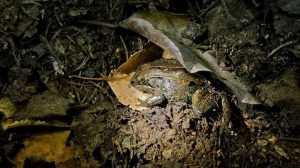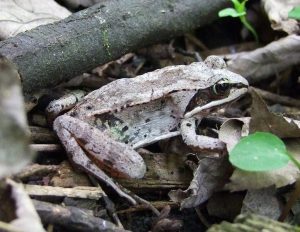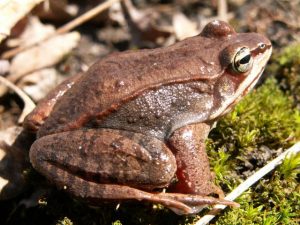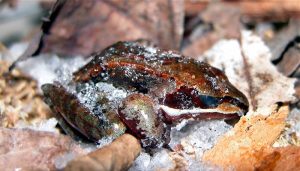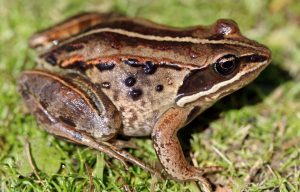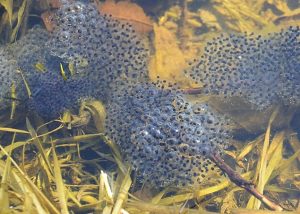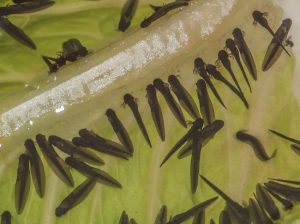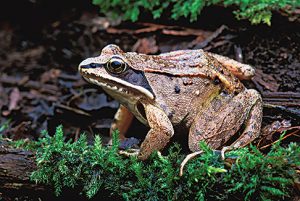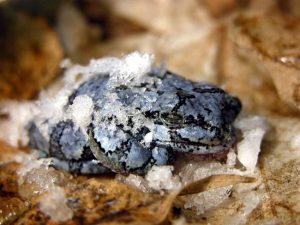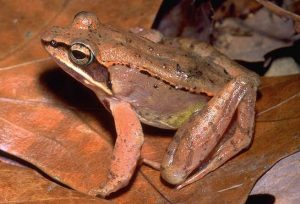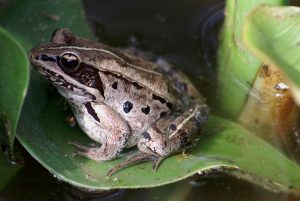Alaskan Wood Frog
The Alaskan wood frog is one of the most widely distributed amphibians in North America, especially in Alaska, the colder parts of Canada, and the contagious United States.
Scientific Classification
| Kingdom | Animalia |
| Phylum | Chordata |
| Class | Amphibia |
| Order | Anura |
| Family | Ranidae |
| Genus | Lithobates |
| Scientific Name | Lithobates sylvaticus |
Quick Information
| Other Names | Grenouille (French), wood frog, North American wood frog, Canadian wood frog, Northern wood frog, Arctic wood frog |
| Physical Description | 1.38-2.99 in, adults are tan, brown or rust, with a dark eye mask; a white line across the upper lip, a light brownish yellow lateral fold in the mid-dorsal area; pale ventral sides with a green or yellow cast; females are larger than males, males more colorful than females |
| Distribution | Northern Georgia, northeastern Canada, southern British Columbia and Alaska; Medicine Bow National Forest |
| Where do they live | Wooded swamps and woodlands |
| Lifespan | Males: 3 years Females: 4 years |
| Vocalizations | Resemble the calls of a flock of ducks; raspy and short quacking sounds |
| What do they eat | Spiders, moth larvae, beetles, slugs, snails; feed on decaying plants, algae, carcasses, eggs and larvae of different amphibians during the larval stage |
| Adaptations | Poisonous glands in older tadpoles for warding off predators, adults have pungent skin secretions effective against shrews, their skin coloration helps them blend in with the forest floor |
| Breeding Season | March to May |
| Breeding Interval | Yearly |
| Predators | Bigger frogs, ribbons snakes, garter snakes, water snakes, skunks, raccoons, mink, and herons prey on adult wood frogs; tadpoles vulnerable to diving beetles, salamander larvae, and water bugs; Eastern newts, leeches, and aquatic insects feed on wood frog eggs |
| Diseases | Ranavirus |
| IUCN Conservation Status | Least Concern |
Behavior
These diurnal animals emit a piercing shriek to startle a predator, forcing it to release the captured frog. While their territories measure around 900 square feet, they come back to their breeding sites every year. They are mostly solitary, congregating at breeding sites. Wood frogs exhibit significant kin recognition capabilities, with tadpoles being able to identify their parents with the use of paternal and maternal factors.
How do they Survive Winter
During winter they freeze themselves, keeping themselves warm by stopping their heartbeats and producing an antifreeze substance that prevents the ice from getting frozen within the cells. Once the temperature rises, they thaw and come back to life.
Mating & Reproduction
Wood frogs start their breeding process as soon as they reemerge from hibernation. They start calling and scouting for mates. However, their inability to differentiate between the sexes necessitates an individual male to embrace all wood frogs. An embraced frog is a male if it makes loud croaking sounds whereas the embracer can find out if the one it has embraced is a female by its body size and fatness.
Once a mate is chosen, mating takes place using an amplexus hold, with the female laying a globular egg mass at the deepest area of the pond. Each egg can be measured at around 3.94-5.12 inches in diameter and consists of up to 1,000-3,000 eggs, which hatch between 9 and 30 days after being laid.
Life cycle
Tadpoles undergo a metamorphosis at around 2 months. Females reach sexual maturity when they are 2-3 years old, while males attain it much earlier at 1-2 years.
Interesting Facts
- Another scientific name for the wood frog is Rana sylvatica.
- The wood frog became the state amphibian of New York State in 2015.
- It is the most abundant frog species in Alaska.
References:
Published on February 2nd 2017 by Sudipto Chakrabarti under Coniferous Forest Animals.
Article was last reviewed on 9th May 2023.


